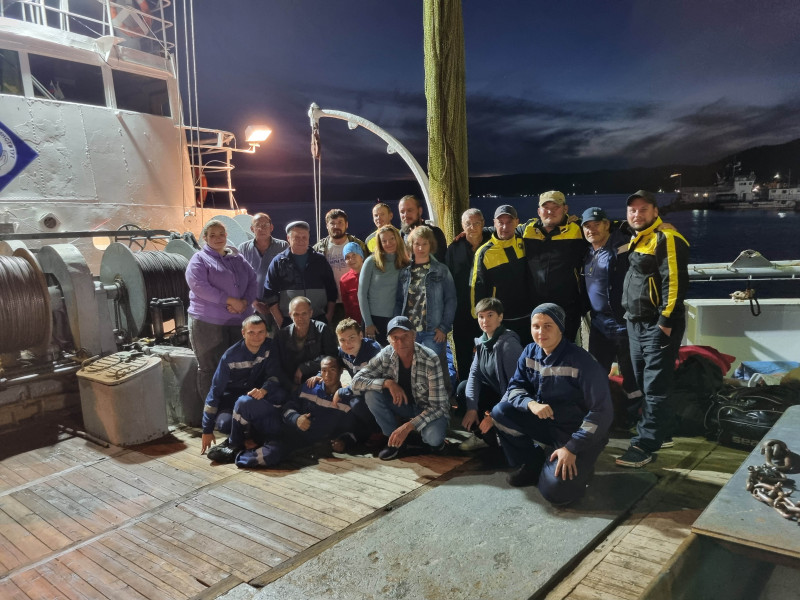Expedition on board the R/V “G.Yu. Vereshchagin” on August 21-31, 2023
On August 21-31, 2023, a research expedition on board the R/V “G.Yu. Vereshchagin” was conducted, the main purpose of which was to study the deep-water fauna of Lake Baikal, the use of new methods in the study of taxonomic diversity, speciation and ecological well-being of deep-water fish of Lake Baikal.
Expeditionary works were carried out within the State assignments: “Study of transformations of the state of water bodies and watercourses of Eastern Siberia in seasonal and long-term aspects in the context of climate change, geological environment and anthropogenic loads” (0279-2021-0005) (led by Fedotov A.P.) and “Genetics of communities of Baikal organisms: gene pool structure, conservation strategies” (0279-2021-0010) (led by Shcherbakov D.Yu.).
Sixteen deep-water trawls were made (maximum depth was 1458 m) and a representative volume of material (samples) on abyssal species of sculpins living in different basins of Lake Baikal was collected for:
- studying adaptive capacities of groundfish to living at depths exceeding 500 m, as well as evaluation of efficiency of biomarkers of well-being of sculpins and whitefish species of different ecological niches: morphofunctional characteristics of sensory systems, DNA methylation, blood cytometric parameters, modulation of gene expression, telomere length and telomerase activity. In field conditions, fixation of various tissues (blood, sensory epithelium, liver, heart) of the following species was carried out: rough sculpin Asprocottus herzensteini, flat-headed sculpin A. platycephalus, dark sculpin Limnocottus griseus, small-eyed sculpin Abyssocottus korotneffi, longfin sculpin Сottocomephorus inermis (3 age groups), sand sculpin Paracottus kesslerii, short-headed sculpin Cottinella boulengeri big Baikal oilfish Comephorus baikalensis. In addition, different age groups of Baikal omul Coregonus migratorius, were captured by gill nets, there were fixed tissues to assess the level of DNA methylation, modulation of gene expression, size of telomere sites and telomerase activity (blood, liver, gill fringes, heart), and to determine the level of cortisol (scales).
- conducting molecular-genetic analysis of the digestive system of deep-water sculpins of Baikal for the presence of parasitic protists - representatives of Diplomonadida, Eimeriorina and Microsporidia, obtaining nucleotide data on genes of the small subunit of ribosomal RNA and the first subunit of cytochrome oxidase of mitochondrial DNA with further phylogenetic reconstruction, determining and comparing the composition of parasitic protists community in species from different ecological niches.
- studying peculiarities of organization of oxygen transport system, leukocytic and erythrocytic groups of peripheral blood cells, cellular immunity system of Baikal sculpins of different ecological niches. During the expedition, erythrocyte lysates were prepared to study hemoglobin structure, blood smears to study morphology and cytometric parameters of blood cells, imprints of hematopoietic organs (spleen and kidney) to assess the immune status of fish, preparations of blood cells and hematopoietic tissues stained with fluorescent dye mitotracker were prepared to identify active mitochondria and assess the energy capabilities of fish organism. Experiments on the effect of table salt solution (0.4 and 0.9 %) on blood parameters of some fish species were carried out.
To study the environmental DNA (eDNA) of river populations of the stone sculpin Paracottus knerii in the tributaries of Lake Baikal, water and soil samples were collected at the mouths of tributaries flowing into the Northern and Central basins of the Lake: along the eastern coast of the rivers: Selenga, Bolshoy Chivyrkuy, Bolshaya Cheremshana, Davshe, Kabanya, Shengangda, Tompuda, Shirilda, Frolikha; along the western coast of the rivers: Tyya, Sarma and Anga. Water samples (~2, 4 liters) were filtered through glass filters, which were packed in test tubes and frozen. The eDNA will be further extracted from the filters and soil samples. The obtained extracts will be analyzed by PCR using allele-specific primers and sequencing of targeted DNA fragments. The obtained data will contribute to supplement information on the genetic population structure of stone sculpn within the lake and the influence of gene flow from river tributary populations on genetic polymorphism.
To study the phylogenetic structure, to search for possible reproductive barriers between morphological species and subspecies of deep-water amphipods, and to identify anatomical features of individual Baikal species and genera, more than 500 specimens were collected during the expedition, including 72 samples from littoral and 206 from deep-water trawls. Deep-water amphipods of the genus Acanthogammarus were sampled from depths ranging from 120 to 1450 meters to assess vertical genetic variability within morphological species.


















